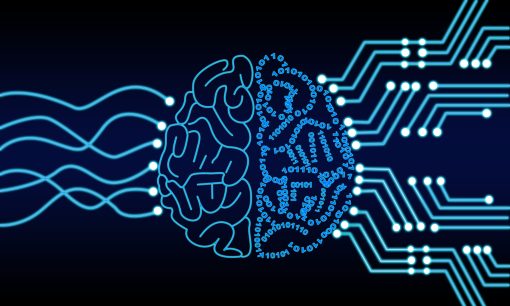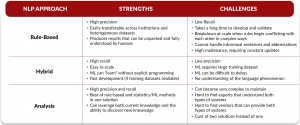
In the rush to digitize the business and practice of healthcare with minimal disruption to clinical workflows, up to 80 percent of captured data is unstructured. This data represents a wealth of potentially valuable information, but its accumulated scale makes it impractical for providers to use it in everyday practice. The leading solution for turning unstructured data into valuable insights is natural language processing (NLP). While NLP is not plug-and-play technology it can address many problems facing the industry.
NLP Overview
NLP is a sub-field of artificial intelligence (AI) that has seen strong acceptance in consumer markets. Perhaps the most obvious example of this technology’s adoption and potential is the rise of smart speakers and virtual assistants, which are quickly becoming accepted in healthcare, too.
NLP’s most common applications are understanding human speech and extracting data from unstructured sources. Chilmark identifies three primary NLP approaches that serve these use cases: rule-based, hybrid, and analysis. As you can see in Table 1, each has advantages and challenges that stakeholders should keep in mind when considering developing or adopting NLP solutions.

Table 1: Strengths and Challenges of NLP Approaches
But what specific opportunities does this technology reveal for providers in the healthcare industry? In our Market Scan Report Natural Language Processing: Unlocking the Potential of a Digital Healthcare Era, we found that NLP is poised to offer substantial savings in both cost and time as well as improve several aspects of care delivery.
NLP in Healthcare
In the course of our research on the applications of NLP in healthcare, Chilmark identified over a dozen key use cases of varying maturity and penetration. Each of these use cases serves a different purpose, but all attempt to address one of the three key drivers for NLP in healthcare:
- Supporting the intensive data analytics needs of value-based care (VBC) and population health management (PHM).
- Coding and analyzing encounters more effectively.
- Decreasing physician workload and burnout.
Regardless of the driver motivating each use case, each can be identified according to its maturity and penetration in the healthcare market. We categorize all use cases as either proven, emerging, or next-generation.

Table 2: NLP Use Cases
Proven NLP Use Cases
Chilmark considers a use case “proven” if it is well-established in the industry and has seen wide adoption across stakeholders. Some of these technologies, such as speech recognition, have been in use for over two decades and seen adoption in large numbers of healthcare providers.
Other examples of proven NLP technologies, such as computer-assisted coding and clinical documentation improvement, are newer, but still promise to improve providers’ bottom lines as well as automate important tasks.
Emerging NLP Use Cases
We also identified NLP use cases that have only recently risen to prominence and are in the early stages of adoption as “emerging.” They are possible in large part because of the wider deployment of big data and rely on real-time analysis plus remarkably high throughput.
While the proven use cases primarily automate, emerging use cases can truly advance and improve care delivery. Clinical trial matching and clinical decision support focus less on simplifying administrative tasks and instead emphasize giving clinicians tools to make better-informed decisions.
Next-Generation NLP
Several more use cases of NLP are in development that promise to further improve care delivery, which we classify as “next-generation.” In the next decade, providers will widely adopt NLP solutions for these use cases.
Eventually, ambient virtual scribes will take lessons learned from Google Assistant and Amazon’s Alexa to give doctors a virtual assistant fine-tuned to operate in the healthcare environment. Computational phenotyping, or cohort discovery, and precision medicine therapies will also be aided by NLP solutions trawling vast unstructured data sources that will identify patient groups far more effectively than experts are currently able to.
Implementing NLP Solutions
When introduced into a new environment, NLP needs time to understand elements such as context, other participants, as well as the rules and goals unique to the data sources it “learns” from. No matter the solution’s maturity or market penetration, implementation and optimization require an iterative approach and the engagement of an interdisciplinary team with expertise in linguistics, data science, machine learning, clinical informatics, and the clinical subspecialty from which data is being analyzed.
To learn more about the implementation challenges of NLP, plus get an in-depth explanation of NLP methodologies and key performance indicators to help develop a shortlist of vendors for evaluation, read our NLP Market Scan Report. It also includes more detail about 12 prominent use cases, profiles of vendors with market-ready solutions, and insights into EHR and cloud vendors developing promising NLP capabilities.




First very informative.
Can you supply us with the names of some companies who can help with the development and implementation of NLP. Specially for the use case of Patient Recorded outcomes?
thanks
lew
Lew, first off sorry for delayed response to your inquiry. Second, most NLP companies will apply their tech stack to pretty much any problem a healthcare organization may have provided you have the $$$ to support its development. At this time, we did not find any vendors that were focusing on this particular problem, likely due to lack of demand. Imagine they’ll get to this issue in time.
Thanks for sharing.
Thanks for sharing this article. Just checking, in the table should the names Hybrid and Analysis be switched around. It seems the description would be better aligned that way. Example, “the cost of two solutions in one” seems to describe a hybrid approach.